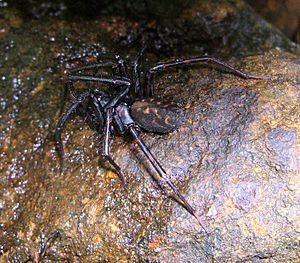Banded tunnelweb spider facts for kids
Quick facts for kids Banded tunnelweb spider |
|
|---|---|
 |
|
| Female | |
| Scientific classification |
The Hexathele hochstetteri, also known as the banded tunnelweb spider, is a type of spider. It belongs to the Hexathelidae family. You can only find this spider in New Zealand. It is quite common on the North Island, but less common on the South Island.
Contents
What Does It Look Like?
The banded tunnelweb spider is one of New Zealand's biggest spiders. Its body can grow up to 20 mm long. This spider is endemic to New Zealand, meaning it lives nowhere else.
The easiest way to spot a banded tunnelweb spider is by the special pattern on its back. It has a yellowish, V-shaped design, called a chevron, on its darker brown abdomen. Its head and body section, called the carapace, is orange-brown. It also has six spinnerets, which are small organs that produce silk. These six spinnerets help tell it apart from other similar spiders. For example, Porrhothele spiders only have four spinnerets.
Banded tunnelweb spiders are part of an ancient group of spiders called Mygalomorphae. These spiders have fangs that point downwards, like pickaxes. When they bite, they press their fangs down instead of pinching sideways. This is a good clue to help identify them.
Where Does It Live?
The banded tunnelweb spider lives only in New Zealand. You can find tunnel-dwelling spiders all over New Zealand. They live in many places, like coastlines, forests, and mountains. The banded tunnelweb spider is most common in the upper North Island of New Zealand.
Home Sweet Home
Banded tunnelweb spiders often live under rocks and logs. But they mostly make their homes in small holes in tree trunks and rocks. They build a silk tunnel inside these holes. The spider waits inside its tunnel for prey to walk by. When a meal comes close, it quickly strikes!
You will rarely see these spiders outside their tunnels. Females almost never leave, unless they are moving to a new home. Males, however, can be seen wandering around. They are usually looking for a mate.
Life Cycle
Scientists don't know much about how banded tunnelweb spiders mate. It's hard to watch them inside their silk tunnels. It is thought that mating happens inside the female's burrow.
When a female spider is ready, she lays her eggs in early to mid-summer. She wraps the eggs in a loose silk sac. This egg sac is kept near the entrance of her burrow. In about 30 days, the baby spiders, called spiderlings, hatch. They stay near their mother's web for a while. Then, they leave to build their own silk tunnels nearby.
The lifespan of these spiders is not fully known. However, males and females live very different lengths of time. After leaving their mother, males only live for a few months. They must find a mate quickly before they die. Females, though, can live much longer. Some have lived up to six years in captivity! Females can shed their skin and have babies many times.
What Do They Eat?
Banded tunnelweb spiders eat most small insects. They wait in their silk tunnel for prey to pass by. At the tunnel's entrance, they build a silk sheet. This silk acts like an alarm, telling them when prey is moving nearby. Once an insect is caught, the spider pulls it into the tunnel.
Scientists have looked at the remains found in their homes. Their diet mainly includes beetles, millipedes, and slaters. But they will attack and eat most small creatures with hard shells. They have even been known to eat snails! Even with a snail's hard shell, the spider can bite it and drag it into its tunnel.
Other Interesting Facts
The banded tunnelweb spider is not dangerous to humans. Its bite can be painful, but its venom does not harm people. It will only cause some soreness and swelling. Even though they are large, these spiders are very shy.
Male banded tunnelweb spiders are sometimes found in sinks and bathtubs. This happens when they wander into homes looking for a mate. They might fall in and get trapped. This is when you are most likely to see a male spider.
While their bite is not serious for humans, the banded tunnelweb spider is closely related to the Australian funnelweb spider. Some Australian funnelweb spiders can be dangerous. Around the world, there are 85 known species of tunnelweb spiders. Twenty-five of these species live in New Zealand.

